Trump’s ‘Liberation Day’ Tariffs: Live Updates & What They Mean for Supply Chains

In a bold return to America-first economic policy, President Donald Trump announced sweeping new tariffs in what the White House has branded as “Liberation Day.” But while the politics are patriotic, the implications for global trade, supply chains, and the U.S. economy are seismic.
The “you-tariff-me, I-tariff-you” approach has sent shockwaves through financial markets and logistics operations.
Nov 1, 2025: U.S.-China Trade Deal Announced
The White House issued an official fact sheet announcing a new U.S.-China economic and trade agreement, formalizing the terms discussed during President Trump and President Xi’s meeting last week.
Key Points:
- Fentanyl Tariff: Reduced from 20% to 10%, effective November 10, 2025
- Reciprocal Tariff: Remains at 10%
- USTR 301 “China Ships” (Penalty) Tariff: Suspended as of November 10, 2025
- Certain USTR 301 Exclusions: Set to expire on November 10, 2026
- China to suspend the implementation of the new export controls on rare earths and related measures
This announcement signals a tentative easing in trade tensions, though implementation details remain fluid ahead. The Trump administration has also announced new trade agreements with Malaysia and Cambodia, as well as new Frameworks for agreements with Thailand and Vietnam.
To Watch: Supreme Court Hearing on IEEPA Tariffs – November 5, 2025
The U.S. Supreme Court is scheduled to hear arguments on the legality of President Trump’s IEEPA-based tariffs.
Even if the Court rules against the administration, officials have indicated the White House could pivot to alternate tariff authorities, such as those under Section 232.
Oct 11, 2025: Additional 100% Tariff on China
President Donald Trump announced that the United States will impose an additional 100% tariff on all Chinese imports starting November 1, 2025, following reports that Beijing plans to introduce sweeping export controls on nearly all categories of goods.
In a Truth Social post, he described China’s move as an “extraordinarily aggressive position on trade”, calling it a “moral disgrace in dealing with other nations.”
Sep 25, 2025: Household Furnishing, Trucks, and Pharmaceuticals Tariffs Announced
On Thursday, President Trump announced sweeping new tariffs:
- Pharmaceuticals: A 100% tariff on branded or patented drug imports, effective October 1, 2025, unless the manufacturer is building a factory in the U.S.
- Heavy Trucks: A 25% tariff on all heavy-duty truck imports
- Household Goods: 50% tariff on kitchen and bathroom cabinets & 30% tariff on upholstered furniture
He described the actions as part of his strategy to bolster U.S. manufacturing and push back on unfair trade practices, aligning with his broader “reciprocal tariff” agenda.
.png)
Sep 10, 2025: Tariff Legality Heads to Supreme Court
The Supreme Court has agreed to hear arguments in early November on whether the Trump administration’s IEEPA tariffs are legal. Meanwhile, President Trump posted on Truth Social that his administration was "continuing negotiations" with India.
Sep 05, 2025: Potential Tariff Adjustments for Aligned Partner
President Trump signed an executive order announcing zero tariffs for a list of imports from “aligned partners” that secure framework agreements with the U.S. Read the Executive Order here.
"My willingness to reduce the reciprocal tariff to zero percent for a given import or to modify tariffs imposed under section 232 will depend on numerous factors, including the scope and economic value of a trading partner’s commitments to the United States in its agreement on reciprocal trade, the national interests of the United States..."
Tariff cuts apply to items that cannot be grown, mined, or produced in the U.S. or are insufficient to meet domestic demand. Exemptions for partner countries with U.S. trade deals begin Monday at 12:01 a.m. EDT.
Furthermore, Treasury Secretary Scott Bessent said on Friday “We would have to give a refund on about half the tariffs, which would be terrible for the Treasury.” Still, he expressed confidence the administration would prevail in the Supreme Court appeal over the legality of Trump’s tariff regime.
Aug 29, 2025: Tariffs Ruled Illegal
A federal appeals court ruled that most of former President Trump's sweeping "reciprocal" tariffs—imposed under the International Emergency Economic Powers Act (IEEPA), were unlawfully enacted, exceeding his executive authority. Nevertheless, the court has allowed the tariffs to remain in effect until October 15 while the administration appeals toward the Supreme Court.
Aug 27, 2025: 50% U.S. Tariffs on Indian Goods Take Effect
Steep U.S. tariffs on a wide range of Indian products officially took effect Wednesday, dealing a major setback to India’s trade with its largest export market.
President Trump initially announced a 25% tariff on Indian goods, but earlier this month signed an executive order adding another 25% in response to India’s continued purchases of Russian oil.
- Effective Rate: Indian exports to the U.S. now face a combined 50% tariff.
- Impact: The Indian government estimates $48.2 billion worth of exports will be affected. (Source: AP News).
De Minimis Exemption Ends August 29
Separately, the long-standing U.S. de minimis rule, which allowed duty-free entry for low-value imports under $800, will end on August 29, 2025.
Aug 21, 2025: U.S.–EU Framework Agreement Announced
The U.S. and European Union issued a joint statement unveiling a framework for a future trade agreement aimed at ensuring “reciprocal, fair, and balanced” trade.
Read the statement here.
Aug 11, 2025: U.S.-China Tariff Truce Extended
The United States and China have agreed to extend their tariff truce for another 90 days, averting the sharp escalation of duties that many feared would trigger a virtual trade embargo between the two nations.
President Donald Trump announced via Truth Social that he had signed an executive order suspending planned tariff hikes until 12:01 a.m. EST on November 10. Without the extension, U.S. tariffs on Chinese goods would have surged from 30% to 145%, while China’s tariffs on U.S. goods would have jumped from 10% to 125%.
Current tariffs on China:
- 10% IEEPA tariff
- 20% IEEPA fentanyl tariffs
- China 301 Tariffs
- Section 232
- Regular & Antidumping duties
The delay comes at a critical moment for U.S. retailers preparing for the end-of-year holiday season, giving importers time to front-load shipments of electronics, apparel, toys, and other seasonal goods without facing punitive tariff spikes.
Read the executive order here.
Aug 7, 2025: Tariffs Take Effect
Reciprocal tariffs across 60+ countries officially took effect today. India-US trade talks are currently on hold. US President Donald Trump stated that negotiations will not resume until the tariff issue is resolved.
Aug 6, 2025: India faces 50% tariffs
President Trump signed an executive order imposing an additional 25% tariffs on India in response to its continued purchase of Russian Federation oil, bringing the total to 50%, effective August 27. He also established a process for the potential imposition of similar secondary tariffs on other countries that directly or indirectly import oil from the Russian Federation.
Read the fact sheet here.
President Trump also said that he will soon be imposing a 100% tariff on all imported chips and semiconductors. Companies that "are building in the United States," like Apple, won't be subject to a forthcoming 100% tariff on imports of semiconductors and chips, Trump said.
Furthermore, any goods found to have been transshipped to evade applicable duties will face an additional 40% tariff.
President Trump also imposed a 35% tariff on Canada and granted Mexico a 90-day extension to reach a trade deal.
July 31, 2025: Tariff Rates Further Modified
On Thursday, President Trump signed an executive order reinstating country-specific tariffs and introducing new rates for over 60 trading partners, effective August 7.
July 30, 2025: Duty-Free De Minimis Treatment Suspended for All Countries
The White House announced today that it will eliminate de minimis treatment for all countries. “Effective August 29, imported goods sent through means other than the international postal network that are valued at or under $800 and that would otherwise qualify for the de minimis exemption will be subject to all applicable duties.”
Here is the Executive Order issued by the White House.
July 30, 2025: 25% Tariff for India, 50% for Brazil
In a Truth Social post on Wednesday, President Donald Trump announced that the United States will impose a 25% tariff on all imports from India beginning August 1, citing persistent trade imbalances and geopolitical concerns. Trump also stated that India will face an additional “penalty”, but did not specify what that might entail.
"Also, they have always bought a vast majority of their military equipment from Russia, and are Russia’s largest buyer of ENERGY, along with China, at a time when everyone wants Russia to STOP THE KILLING IN UKRAINE — ALL THINGS NOT GOOD!”- President Trump on Truth Social.
The White House has formally posted an executive order imposing an additional 40% tariff on imports from Brazil under the International Emergency Economic Powers Act (IEEPA). Combined with the existing 10% IEEPA baseline tariff, this brings the total effective tariff rate on Brazilian goods to 50%. This is the first official notice of the Brazil-specific tariff increase, which had been anticipated but not yet formally issued. Brazil was notably not listed among the countries previously hit with reciprocal tariffs.
July 28, 2025: U.S. and EU Reach Trade Agreement Ahead of August Deadline
The United States and the European Union have reached a trade agreement, just days before the August 1 reciprocal tariff enforcement date. While full details have yet to be released, initial reports confirm that the deal will impose a 15% tariff on most EU goods entering the U.S.
The agreed-upon 15% tariff is:
- Lower than the previously threatened 30% rate slated for August 1
- Higher than the pre-trade war average of 2–3%, marking a significant long-term shift in transatlantic trade costs
The Guardian reported that "On Sunday, a senior US administration official told reporters in Washington that Trump retained the ability to increase the tariffs in the future if European countries do not live up to the investment commitments contained in the deal."
Read: Statement by President von der Leyen
July 27, 2025: U.S.-China Tariff Truce Likely to Be Extended by 90 Days
According to a report from the South China Morning Post, Beijing and Washington are expected to extend their current tariff truce by another 90 days. This development comes ahead of a fresh round of bilateral trade talks beginning Monday in Stockholm. During the extension period, both countries are expected to refrain from introducing new tariffs or taking other escalatory measures. The current truce, set to expire on August 12, temporarily lowered tariffs that had previously climbed above 100% on both sides.
July 22, 2025: Deals announced for Japan, Philippines, and Indonesia
With the August 1 reciprocal tariff reinstatement deadline fast approaching, President Donald Trump announced three new trade developments, striking fresh deals with the Philippines, Indonesia, and Japan.
Shortly after a high-profile Oval Office visit by the Philippine president, Trump announced a trade deal under which the U.S. will impose a 19% tariff on imports from the Philippines. The Philippines will eliminate tariffs on all U.S. goods, according to Trump’s Truth Social post. The Philippine government has not officially confirmed the deal or its terms as of today.
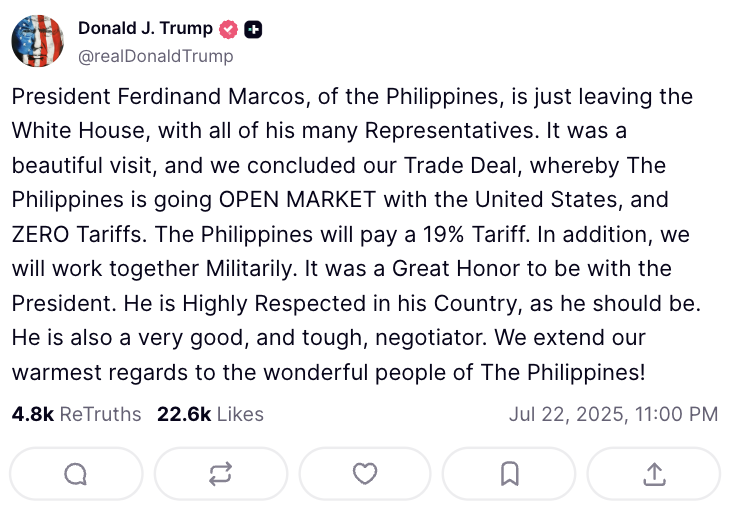
The White House issued a joint statement confirming a framework trade agreement with Indonesia. Key elements:
- The U.S. will apply a 19% tariff on Indonesian imports
- Indonesia will scrap most tariffs on American goods
- The deal is being positioned as an “Agreement on Reciprocal Trade”
This comes after weeks of uncertainty following Indonesia's initial inclusion in the July 7 tariff notice (32% rate). The new 19% figure reflects a reduction following successful bilateral talks.
Read the official statement here.
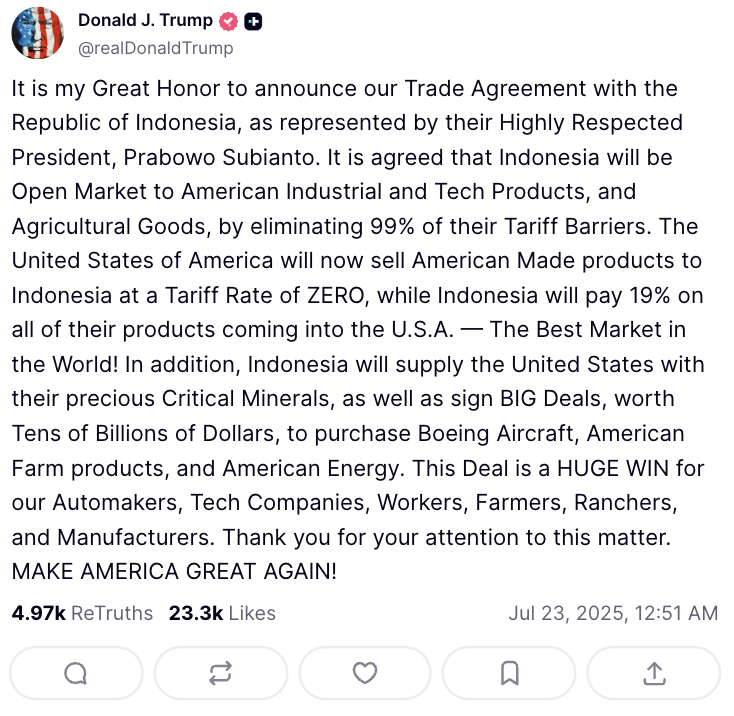
In another major development, Trump announced a sweeping trade deal with Japan, reducing the tariff rate on Japanese imports to 15%. This follows:
- An original April 2 threat of 24% tariffs
- A July 7 letter stating a 25% rate would be imposed
- A new deal that now makes Japan’s 15% rate the lowest among major trade partners
Japanese Prime Minister Shigeru Ishiba confirmed the agreement, noting that Japan’s concessions came in exchange for protecting key export sectors while maintaining favorable terms for U.S. imports.
Read the fact sheet here.
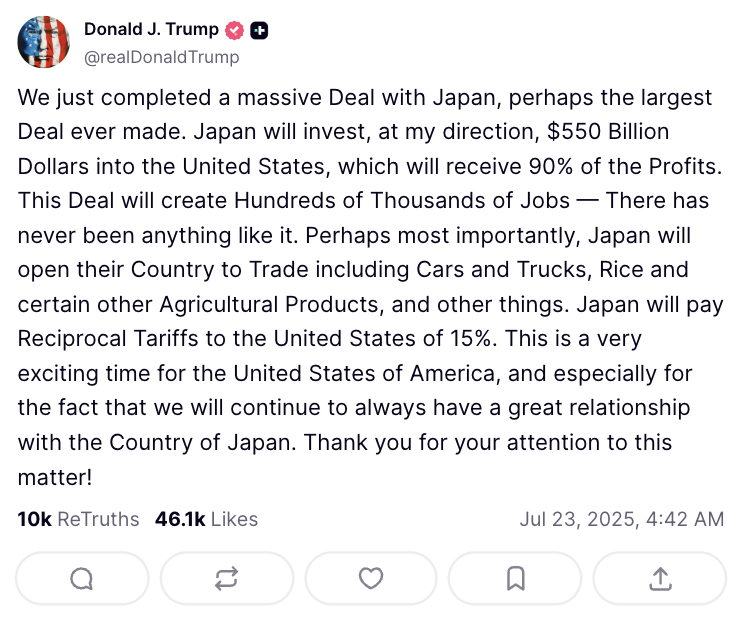
President Trump announced a trade deal with Vietnam earlier this month but with no official details released, confusion is mounting. With tariffs set to increase for most countries on August 1, importers are left guessing what, if anything, will actually change before the deadline.
July 14, 2025: New Tariff Warnings to Mexico and the EU
Today, President Trump posted two new tariff letters on Truth Social, this time addressed to Mexico and the European Union. In each letter, Trump warned that if the respective governments fail to finalize “acceptable trade agreements,” the U.S. will impose 30% tariffs on all imports from each region. The letters also caution against retaliation, stating that the U.S. will match any retaliatory tariffs with equivalent duties.
This brings the total number of countries receiving tariff letters to 25 since the administration began issuing notices last week.
A few key updates from ongoing U.S. bilateral trade negotiations:
- Anonymous White House officials told the press that the planned Canada tariffs will only apply to goods not complying with the USMCA. However, final decisions still rest with President Trump.
- Mexico tariffs announced today are presumed to also exempt USMCA-eligible goods, although this has not yet been confirmed.
- China still faces an August 12 deadline to strike a deal with the U.S.
- U.S. and Vietnamese negotiators were closing in on an 11% tariff rate, but President Trump ultimately announced a 20% rate in the final version of the deal.
Source: Accelerate Strategies
July 9, 2025: The Second Wave of Tariff Letters
Following Monday’s sweeping actions, the Trump Administration issued 7 more tariff letters—with rates set to take effect August 1, 2025, unless bilateral trade deals are struck. The letters were posted on Truth Social.
Affected countries include:
- Philippines: 20%
- Iraq: 30%
- Algeria: 30%
- Libya: 30%
- Brunei: 25%
- Moldova: 25%
- Sri Lanka: 30%
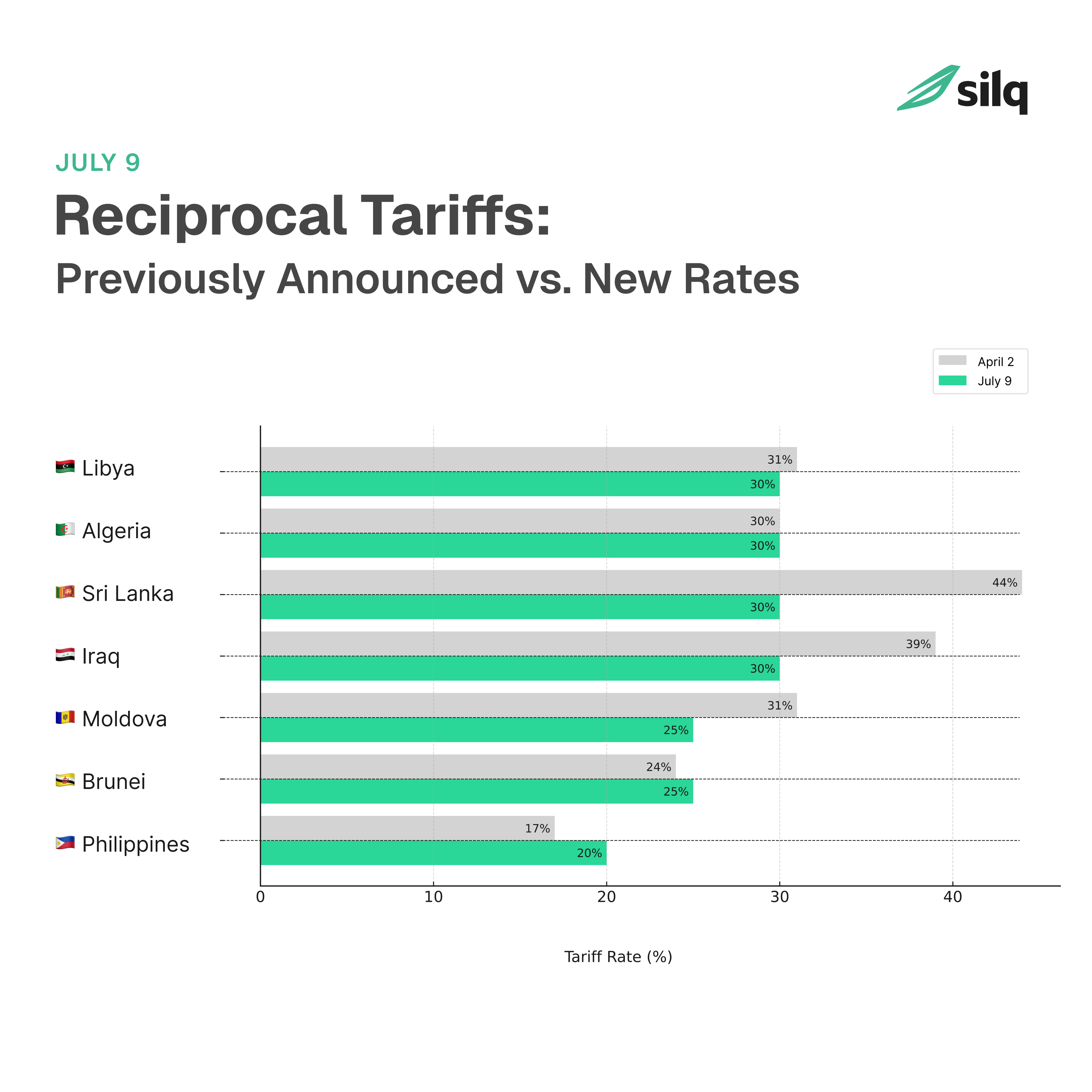
President Trump also announced plans to impose 50% tariffs on imports from Brazil.
July 7, 2025: First Round of Tariff Letters Issued
The Trump administration began issuing formal tariff notices today to countries that have not secured trade agreements ahead of the looming August 1 deadline. The letters, also posted on Truth Social, outline new U.S. tariff rates- some of which exceed the April 2 “Liberation Day” levels, while others are slightly reduced.
Country
New Tariff Rate
🇯🇵 Japan
25%
🇰🇷 South Korea
25%
🇹🇳 Tunisia
25%
🇲🇾 Malaysia
25%
🇰🇿 Kazakhstan
25%
🇿🇦 South Africa
30%
🇧🇦 Bosnia & Herzegovina
30%
🇮🇩 Indonesia
32%
🇷🇸 Serbia
35%
🇧🇩 Bangladesh
35%
🇹🇭 Thailand
36%
🇰🇭 Cambodia
36%
🇱🇦 Laos
40%
🇲🇲 Myanmar
40%
These tariffs apply to all goods imported from each country and are in addition to sector-specific duties, such as Section 232 steel and aluminum tariffs.
.png)
Source: Accelerate Strategies
July 7, 2025: Additional 10% tariffs for BRICS
President Trump announced that any country aligning with the "Anti-American policies" of BRICS, will be charged an additional 10% tariff. The announcement came as the bloc’s meeting is underway in Rio de Janeiro, Brazil.

July 6, 2025: Tariff Deadline Shift- August 1 Confirmed
On Sunday, Treasury Secretary Scott Bessent confirmed that U.S. tariffs will snap back to “Liberation Day” levels on August 1, 2025, for countries that do not finalize trade agreements by then.
“I think we’ll have most countries done by July 9, yeah. Either a letter or a deal.”- President Donald Trump.
Letters with warning notices will be sent starting Monday to US trading partners, reminding them that tariffs will boomerang back to the April 2nd level. Bessent also stressed that this is not a new deadline for negotiations- “We are saying this is when it’s happening. If you want to speed things up, have at it. If you want to go back to the old rate, that’s your choice.”
Read More: The Executive Order Extending the Tariff Delay to August 1
June 30, 2025: Trade Discussions With Canada Terminated
President Trump announced on Truth Social today that the U.S. is “terminating all discussions on trade with Canada, effective immediately,” in light of Canada’s digital services tax on American technology companies.

Current tariff structure on Canadian imports:
- General tariff rate: 25%
- Energy products: 10%
- USMCA-covered goods: 0%
June 27, 2025: China Deal Signed, President Trump Teases India Talks
On Thursday, President Donald Trump announced that the U.S. has officially signed a trade deal with China, marking a significant milestone just 12 days before the July 9 tariff deadline.
The final text of the agreement has not been made public. Market participants are watching closely for clarification on enforcement, implementation dates, and scope. Follow-up statements from White House officials indicate that this agreement focuses on securing U.S. access to Chinese rare earth minerals.
Trump also hinted at another major deal in the works:
“We have one coming up maybe with India. A very big one where we’re going to open up India.”
President Trump promised "90 deals in 90 days" before the deadline of July 9, however he said that he was "not going to make deals with everybody." "Some we're just going to send them a letter and say thank you very much, you're going to pay 25, 35, 45 per cent, that's the easy way to do it."
Treasury Secretary Scott Bessent had previously signaled the administration may extend the 90-day pause, further clouding what the July 9 landscape may look like.
June 11, 2025: Trump Confirms U.S.-China Trade Framework
President Trump, in a Truth Social post on Wednesday (June 11), revealed that following several days of intense trade negotiations in London, which followed earlier discussions in Geneva, the U.S. and China have reached a preliminary framework agreement pending final sign-off.
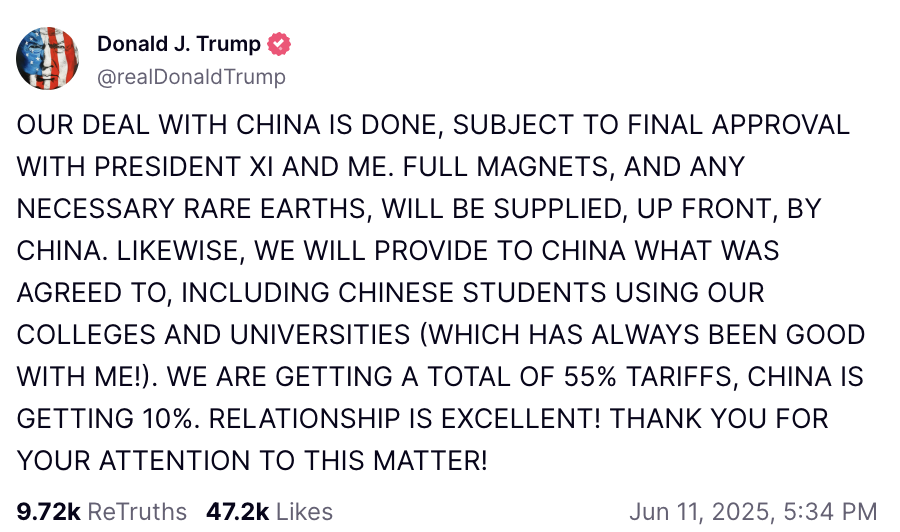
Tariffs to Hold at 55%
The headline figure caused confusion at first, but the White House clarified the 55% rate is a composite of:
- 25%: Section 301 China tariffs (pre-existing)
- 20%: Fentanyl trafficking levy
- 10%: Global “reciprocal tariff” applied to all trading partners
China will maintain its 10% tariff on U.S. imports. China has also agreed to resume exports of rare earth minerals and magnets–essential to U.S. tech and defense supply chains. The export window is reportedly limited to six months, pending further talks.
The clock is still ticking. If you’re importing from China, or hedging against further volatility, now’s the time to act. Talk to a Silq expert today.
May 29, 2025: Appeals Court Temporarily Reinstates Trump-Era Tariffs
A federal appeals court has issued a temporary stay, allowing the controversial “Trump Tariffs” to remain in effect for now. This decision reverses a lower court ruling from earlier in the week that deemed the tariffs illegal under the IEEPA.
While the case proceeds, U.S. Customs and Border Protection may continue collecting the tariffs — including those targeting Chinese goods under the “Reciprocal” and “Fentanyl” labels. However, the legal fight isn’t over, and future rulings could halt collections or trigger refunds.
May 28, 2025: Tariffs Ruled Illegal by Federal Court
The United States Court of International Trade declared the IEEPA tariffs invalid. This includes the “Fentanyl” and “Reciprocal” Tariffs put in place by the current administration.
The government is expected to appeal (and likely seek a stay). But unless a higher court pauses enforcement, CBP may be required to stop collecting these tariffs and could be on the hook for refunds of duties already paid.
Read the court ruling here.
Update: The Trump administration has already appealed the ruling as expected.

May 25, 2025: EU Tariffs Delayed Until July 9
President Donald Trump announced on Sunday, that he would delay a planned 50% tariff on imports from the European Union, originally set to take effect June 1. The new target date is July 9, 2025.

The decision came just days after Trump had sharply criticized the EU for making “no progress” in trade negotiations and vowed to impose steep duties. However, following a call with European Commission President Ursula von der Leyen, the administration chose to restore the original July 9 window, giving both sides more time to reach a deal.
May 22, 2025: Tariff Deadlines Watch: What’s Next?
The 90-day suspension of reciprocal tariffs for multiple U.S. trading partners is projected to end on July 9, while the temporary U.S.-China tariff truce is expected to expire on August 14, 2025. If no new agreement is reached, tariffs could revert to previous levels.
Space Crunch Out of China
Shipping demand has spiked in the wake of the U.S.-China truce:
- Container bookings from China to the U.S. have surged by approximately 277%, as importers aim to expedite shipments before potential tariff hikes.
- Ocean freight rates have climbed, with the Drewry World Container Index reporting an 8% week-over-week increase as of May 15.
What to Do Now
- Secure sailings/air allotments for July deliveries; consider LCL or SCL alternatives if FCL space is scarce.
- Model tariff reversals into your landed cost models, P&L forecasts, and reorder timelines.
- Add extra lead-time for port congestion and possible rolled cargo through mid-August.
- Have contingency plans in case tariffs snap back or logistics bottlenecks worsen.
If you’re rethinking your sourcing strategy or need better landed cost clarity, now’s the time to activate Silq Edge–our new personalized toolkit for importers to navigate tariff volatility. Get free HTS classification reviews, factory audits, and shipment tracking to help you recalibrate your supply chain with speed and confidence.
May 18, 2025: Fresh Signals from Washington
On May 18, 2025, Treasury Secretary Scott Bessent indicated that tariff rates might return to the ‘Liberation Day’ levels if countries don’t reach trade agreements during the 90-day pause.
“President Trump has put them on notice that if you do not negotiate in good faith, you will ratchet back up to your April 2 level.” Bessent said.
This comes after the president suggested that the administration will “be telling people what they’ll be paying to do business in the United State” at a business roundtable in the United Arab Emirates on May 16.
May 11, 2025: U.S. Announces China Trade Deal in Geneva
In a joint statement, the United States and China announced they would lower their respective tariffs for 90 days while they negotiate a broader trade agreement. Effective Wednesday, the U.S. will lower tariffs on Chinese imports from 145% to 30%, while China will reduce its tariffs on U.S. goods from 125% to 10%.
This agreement follows high-level talks in Geneva between U.S. Treasury Secretary Scott Bessent, Trade Representative Jamieson Greer, and Chinese Vice Premier He Lifeng. The temporary truce aims to alleviate the economic strain caused by the trade war, which had disrupted approximately $600 billion in bilateral trade.
"The consensus from both delegations this weekend is neither side wants a decoupling." - U.S. Treasury Secretary Scott Bessent
Both nations have committed to ongoing discussions to address underlying trade issues, with the 90-day period serving as a window for further negotiations. Financial markets responded positively to the news, with U.S. stock futures rising and the dollar strengthening against major currencies.
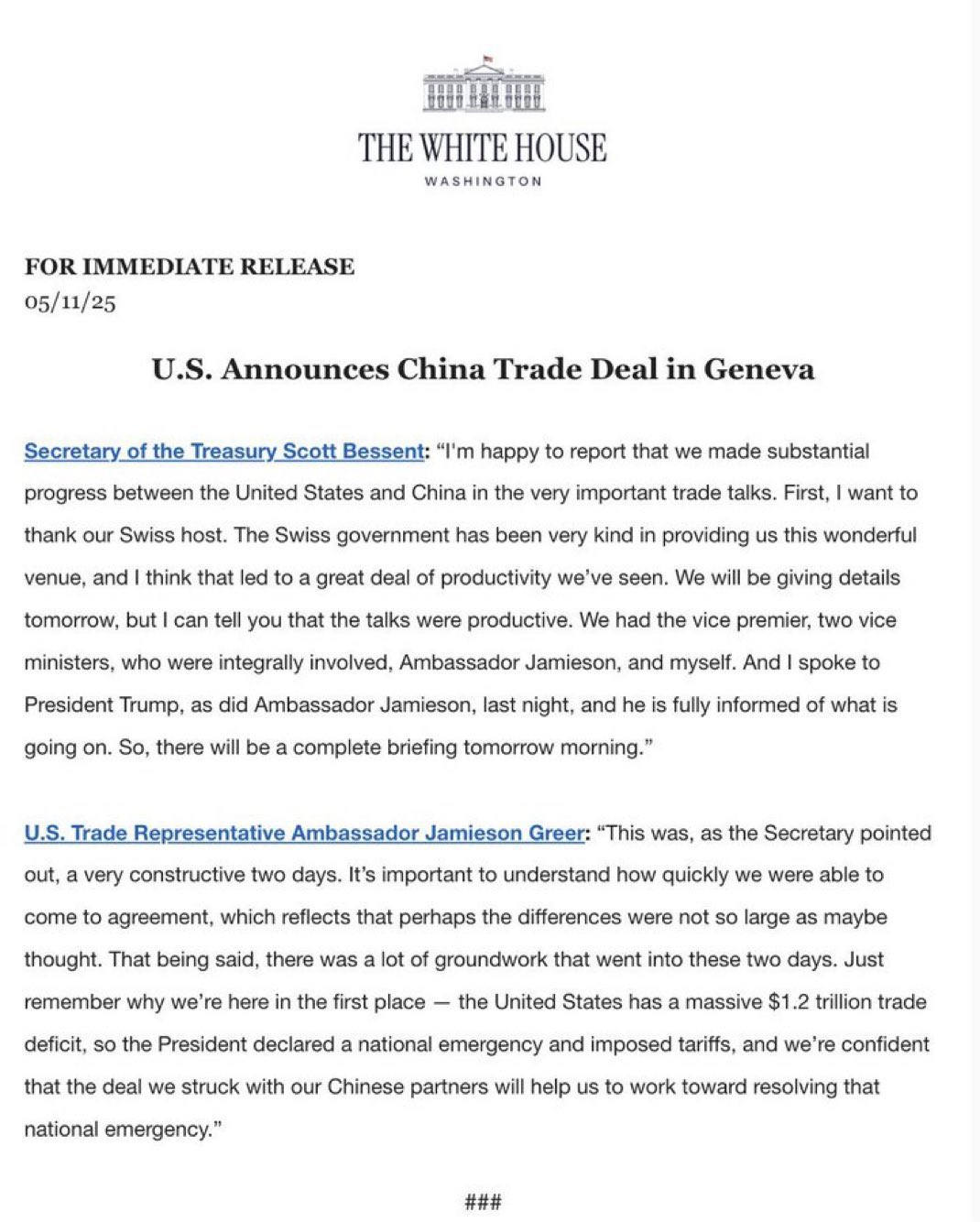
May 8, 2025: U.S.-UK Reach Historic Trade Deal
On May 8, 2025, President Donald Trump and U.K. Prime Minister Keir Starmer announced a historic trade agreement–the first major bilateral deal under the U.S.'s new reciprocal tariff regime. While the 10% baseline tariff remains in place, the agreement introduces significant sector-specific relief and expanded market access for both nations.
- The agreement opens approximately $5 billion in export opportunities for U.S. farmers and producers, including over $700 million in ethanol exports and $250 million in other agricultural products.
- The deal includes provisions to enhance the competitiveness of U.S. aerospace manufacturers through preferential access to UK aerospace components and establishes a secure supply chain for pharmaceutical products.
- The first 100,000 vehicles imported into the U.S. by UK car manufacturers annually are subject to 10% reciprocal tariffs, and additional cars are subject to 25% rates.
- Both countries commit to streamlining customs procedures and reducing non-tariff barriers, facilitating smoother trade flows.
The announcement positively impacted financial markets. The S&P 500 rose by 1.3%, with notable gains in companies like Boeing and Rolls-Royce.
Read the White House fact sheet here.
May 7, 2025: U.S.-China Trade Talks to Commence
The United States and China have agreed to initiate high-level trade discussions in Switzerland from May 9 to 12, 2025, marking the first formal engagement since the imposition of significant reciprocal tariffs earlier this year. U.S. Treasury Secretary Scott Bessent and Trade Representative Jamieson Greer will meet with Chinese Vice Premier He Lifeng to address the escalating trade tensions.
The talks aim to address the severe disruptions caused by the trade war, which has led to significant economic consequences for both countries and the global market. While the initiation of dialogue is a positive step, both sides remain cautious, and substantial progress will depend on mutual concessions and a commitment to resolving the underlying issues.
However, on Wednesday, President Trump said he will not reduce the current 145% tariffs on Chinese goods as a precondition for negotiations. China's Ministry of Commerce has expressed that any dialogue must be based on equality and mutual respect, warning against coercion and unilateral pressure.
“China very much wants to make a deal,” Trump said. “We’ll see how that works out.”
Apr 22, 2025: China Tariffs to “Come Down Substantially”
On Tuesday, President Donald Trump acknowledged that the current 145% tariffs on most Chinese imports would be reduced as part of ongoing trade negotiations with Beijing. However, he emphasized that the tariffs would not be eliminated entirely, stating, "it won’t be zero."
This admission follows a series of escalating tariff measures initiated by the Trump administration earlier this year, which have significantly impacted global markets and strained U.S.-China trade relations. In retaliation, China has imposed its own set of tariffs and export restrictions, particularly targeting critical rare earth minerals essential to various industries.
Treasury Secretary Scott Bessent has described the current tariff levels as "unsustainable" and suggested that de-escalation would begin with lowering tariffs, although formal negotiations have yet to commence. (Source: Reuters)
“We’re going to be setting the deal, and it’ll be a fair deal for everybody, and it’ll be - I think it’s a process that’s going to go pretty quickly.” - President Trump
The outcome of these negotiations remains uncertain, but any reduction in tariffs could have significant implications for international trade dynamics and economic stability.
April 17: U.S. Imposes New Fees on Chinese-Built Vessels
The USTR announced new voyage-based fees on Chinese-built vessels following a Section 301 investigation into China's acts to dominate the maritime, logistics, and shipbuilding sectors. The investigation, spanning both the Biden and Trump administrations, concluded that China’s policies were unreasonable and harmful to U.S. commerce.
“These actions will begin to reverse Chinese dominance... and send a demand signal for U.S.-built ships. - U.S. Trade Representative Jamieson Greer
Read the official release: USTR Section 301 Action – April 17
President Trump, meanwhile, took to social media to spotlight recent trade talks:

April 15, 2025: China now faces up to 245% Tariffs
China now faces a 245% tariff on imports to the United States. This includes a 125% reciprocal tariff, a 20% tariff to address the fentanyl crisis, and Section 301 tariffs on specific goods, between 7.5% and 100%.
White House officials confirmed the administration simply added up existing levies:
- EVs: 25% under Trump (first term) + 100% under Biden → now included in Trump’s second-term 145% tariff plan.
- Syringes: Also received a 100% tariff under Biden, included in the new count.
Coming in 2026: Tariffs on some medical goods, like rubber gloves, are scheduled to rise to 245%.
Separately, President Trump signed an Executive Order probing national security risks tied to the U.S. reliance on imported critical minerals.
(Source: The Wall Street Journal)
April 10, 2025: 145% China Tariffs
The White House clarified that the newly announced 125% tariff on Chinese imports is in addition to an existing 20% levy previously imposed due to China’s alleged role in supplying fentanyl to the U.S, bringing the total tariff rate to 145% on all imports to the United States.
In response, China’s Ministry of Finance announced a retaliatory increase on U.S. goods to 125%, up from the previous 84%.
“Even if the U.S. continues to impose higher tariffs, it will no longer make economic sense and will become a joke in the history of world economy,” the ministry stated.
The Trump administration has exempted goods already in transit from the new tariff rates, giving importers a brief window before the financial impact hits.
April 9, 2025: A 90-Day Pause With the Exception of China
Just hours after China announced steep retaliatory tariffs on U.S. goods, President Donald Trump announced a 90-day pause on the implementation of new tariffs that went into effect at midnight. However, the 10% universal tariff will remain in place on all imports from these nations during the pause.
Notably, China is not included in this tariff suspension. Instead, the U.S. has increased tariffs on Chinese imports to 125%, effective immediately. According to President Trump, this escalation is a response to the “lack of respect that China has shown to the World’s Markets.”

Markets reacted positively to the announcement. The S&P 500 surged by 7.8%, putting it on track for its largest single-day gain in five years. The Dow Jones Industrial Average climbed 2,382 points, or 6.3%, marking its strongest performance since 2020. Meanwhile, the Nasdaq Composite soared nearly 10%.
April 9: China’s “Fight to the End”
In a significant escalation of the ongoing trade war, China announced that it will impose 84% tariffs on all imports of U.S. goods, effective April 10.
This move was in direct response to President Donald Trump's implementation of cumulative tariffs totaling 104% on Chinese goods. The tit-for-tat tariffs have unsettled global financial markets, with major indices in Europe and Asia experiencing sharp declines.
“They have the most imbalanced economy in the history of the modern world, and I can tell you that this escalation is a loser for them.”- U.S. Treasury Secretary Scott Bessent
Countries like Canada and Mexico are also evaluating their responses, with potential retaliatory tariffs on U.S. goods being considered. The situation remains fluid, with potential for further escalations or negotiations.
April 8: Tariffs on China Surge to 104%
The White House has confirmed that President Donald Trump will impose an additional 84% in levies on all imports from China, raising the effective tariff rate to 104% across the board.
President Trump has instructed his trade team to craft “tailor-made deals” for countries open to negotiation. Talks are already underway with South Korea, which the President said is nearing the “confines of a deal.” The European Union has also signaled interest in negotiating over buying more natural gas in exchange for de-escalation.
Markets Drop Again
After a brief morning rally driven by hopes for negotiation, U.S. markets turned south after the tariff announcement.
- Dow Jones: -320 points (-0.84%)
- S&P 500: -1.57%
- Nasdaq Composite: -2.15%
This brings cumulative losses for U.S. markets to nearly 10% over the last week, reflecting mounting concern over the U.S. economy, rising costs for importers, and worsening trade relations.
April 3, 2025: Markets React
In the aftermath of President Trump's sweeping tariff announcements that essentially launched a global trade war, the financial markets have experienced significant volatility.
- The U.S. dollar has notably weakened against major currencies, reaching six-month lows against the Euro, Japanese yen, and Swiss franc.
- Wall Street took a beating. Following the tariff announcement, U.S. markets posted their sharpest single-day declines since the early COVID-19 pandemic:
- S&P 500: down 4.8%
- Dow Jones: down 1,679 points
- Nasdaq Composite: down 6%
- Spot gold has surged to record highs above $3,100 per ounce, driven by fears of a global economic slowdown and inflationary pressures stemming from the new tariffs.
- U.S. Treasury yields have fallen as investors flock to the relative safety of government debt, anticipating potential economic downturns and possible interest rate cuts by the Federal Reserve.
- JP Morgan has raised its forecast for a global recession. It now assigns a 60% probability that the world economy will slip into recession by the end of the year, up from its previous estimate of 40%.
- China retaliates with 34% retaliatory tariffs on US imports.
- Major U.S. trading partners are preparing countermeasures with some exploring retaliatory tariffs on U.S. pharmaceuticals and agricultural products, reevaluating trade ties, and raising non-tariff barriers.
April 2, 2025: Tariffs Announced
In a Rose Garden press conference, U.S. President Donald Trump announced a comprehensive set of higher tariffs, referred to as "Liberation Day" tariffs, imposing a 10% duty on all imported goods and higher rates on imports from specific countries.
This announcement is part of a broader narrative from the Trump administration: restoring U.S. leverage in global trade through targeted, retaliatory tariffs. But what’s clear from logistics leaders and economists alike is that this move, regardless of its political framing, introduces new uncertainty into already fragile global networks.
- Following the announcement, the S&P 500 index futures fell by 2.9%, and Dow Jones Industrial Average futures declined by 2.2%.
- During trading hours, the stock market recovered slightly as congressional Republicans hinted at efforts to moderate the policy through Senate negotiations. But experts remain cautious. The S&P 500 gained 0.7%, closing at 5,670.97, and the Dow rose 0.6% to 42,225.32. The Nasdaq Composite also increased by 0.9%, ending at 17,601.05.
- Analysts expressed concerns that these tariffs could cost the average U.S. household approximately $3,800 annually, potentially leading to inflation and reduced consumer spending.
- Internationally, markets also reacted negatively. The Nikkei 225 in Japan fell 2.8%, while European indices like the FTSE 100 and Germany's DAX experienced declines of 1.6% and 3.1%, respectively. Investors worldwide are bracing for potential retaliatory measures from affected countries, which could further impact global trade and economic stability.
De Minimis Elimination for China & Hong Kong (Effective May 2, 2025)
Previously announced in February and now finalized via executive order:
- All low-value shipments (<$800) from China and Hong Kong will no longer qualify for duty-free treatment.
- Per the White House: “Adequate systems are now in place to collect all tariff revenue.”
- U.S. companies relying on low-cost fulfillment from China will be hit hard by this policy shift.
What This Means for U.S. eCommerce Brands & Consumers
Economists warn that the tariff shock could widen the U.S. trade deficit, increase prices for consumers, and slow manufacturing output. U.S. ecommerce brands, particularly those that import finished goods or private-label SKUs from China, Vietnam, or India, will feel the squeeze almost immediately.
- Product prices will rise as brands pass tariff costs on to shoppers.
- Inventory planning becomes more volatile, with brands forced to make faster decisions with less certainty.
- DTC brands using 3PLs may see warehousing costs rise as safety stock strategies shift.
Examples of the U.S. tariff impact for consumers:
- $90 athletic wear turning into $110+
- $25 kitchen gadgets suddenly costing $35
- Slower restocks and more “out of stock” banners
Strategies for Brands to Mitigate Tariff Impacts
Is this permanent? Should you shift factories? Move everything nearshore? Pause and reassess?
Our advice – Stay nimble. Diversify. And don’t over-correct too early.
The long-term ramifications remain unknown. What we do know is that overreacting to headlines without analyzing the long-tail impact can be just as damaging as standing still.
Recommendations from Silq experts:
- Start modeling tariff scenarios by country of origin. Use freight + tariff combined landed cost models to guide decision-making.
- Assess your current supplier network. If you’ve been thinking about nearshoring or multi-country sourcing, now’s the time to accelerate.
- Request factory-level visibility. Understanding production schedules can help you make smarter calls about front-loading or shifting orders.
- Work with a customs partner who can advise, not just clear. The rules are changing—and you need someone who reads between the lines.
What We're Watching:
- Retaliatory tariffs from the European Union, India, Canada, and Mexico
- USTR clarifications and sector-specific exemptions
- Rising non-tariff barriers and friction within existing trade agreements
- A shift toward non-U.S. stocks as investors look for better risk/reward scenarios
- Policy reactions from Congress, the Senate, and economists across political lines
- Escalating pressure on free trade allies and potential countermeasures from China and Taiwan
Final Thoughts
We’re in uncharted territory. Whether you call it protectionism or policy recalibration, one thing is clear: “Liberation Day” is a pivot point for American trade policy.
If your business depends on overseas suppliers, now is the time to take stock—literally and strategically. This is your cue to get proactive, not reactive.
Silq is here to help. From baseline cost modeling to supplier diversification and customs compliance, we provide clarity in moments of chaos. We will continue to monitor the policy environment and provide real-time updates, strategy briefs, and country-by-country impact assessments. Let’s talk if you need help stress-testing your sourcing or shipping strategy.
Ready for Supply Chain Predictability?
Importers using Silq ship smarter, safer, and with total control.







